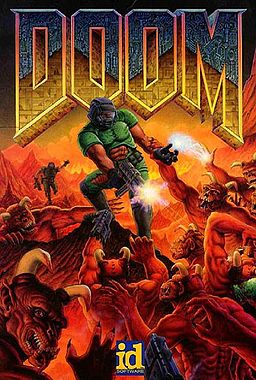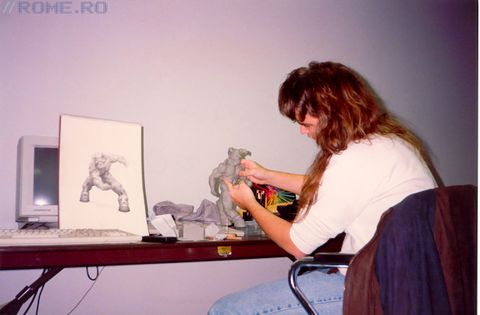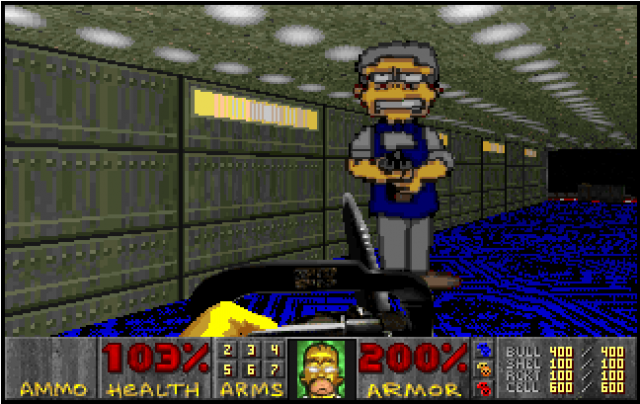Synopsis
Doom is a first-person shooter game developed by id Software. Players assume the role of a space marine, popularly known as Doomguy, fighting his way through hordes of invading demons from Hell.

Official website: https://bethesda.net/en/store/product/DO1GNGPCBG01
Lenses
Lens 9: The Elemental Tetrad
Aesthetics

Doom’s art style is made to be “nightmarish”: a mix of sci-fi weaponry, xenomorphic aliens, and Hell. This places an emphasis on the environment, and especially on the design of the monsters. Monsters are sculpted from clay, and then photographed from different sides to get a realistic 2.5D-style graphics: 2D sprites with multiple viewing angles.

The music used in the game further evokes this imagery, with heavy inspiration on metal bands such as Metallica, Black Sabbath, and Alice in Chains.
Technology
id Software used DOS to develop its previous titles, but switched to the NeXTSTEP operating system for Doom (despite it being developed for DOS). This switch gave the team a much improved development environment, with high screen resolution and better graphics, which was a huge step forward in iteration time and overall productivity.
Doom demands a fairly beefy computer at its time, but this was acceptable given how fast the hardware space was evolving in those days. To compensate, the Doom engine employed clever tricks to squeeze out maximum performance, one of which being the use of fixed-point arithmetic. Computers back then had slow floating-point arithmetic performance. To alleviate this, the engine used integers split into an integral part and a fractional part to represent decimals. This allows arithmetic using normal integer instructions which is much faster. Nowadays this workaround is obsolete, since modern CPUs have dedicated floating point units, and even modern GPUs are compared to each other in terms of floating point operations per second (FLOPs).
Doom’s assets are stored in WAD files, short for “Where’s All the Data”, which allows not only easy swapping of game assets, but also makes it easy to develop and distribute custom modifications.
Mechanics
Most first-person shooters of late follow the same mantra for their game mechanics: aim, shoot, cover. Doom takes a different approach: like its predecessors, the low punishment of getting hit, the abundance of pickups, and the plethora of secret locations motivate the player to take on a more reckless and explorative gameplay.
The selection of weapons and level design adds to this mindset, giving the player more options to decimate hellspawns, from environment hazards like explosive barrels and crushing walls, to the Big F***ing Gun.
Story
The game follows a simple narrative: Earth’s last man shoots satanic alien demons that invaded Earth. The protagonist? We call him the “Doomguy”. Name is irrelevant – he’s here to slay demons, not befriend them. As John Carmack put it: “Story in a game is like story in a porn movie. It’s expected to be there, but it’s not that important.” This doesn’t generalize for all games, of course, but it certainly applies for Doom.
Lens 38: Challenge
You start with a pistol, finding your way around a hangar, surrounded by what were your comrades, but are now zombie troopers. It’s a straightforward level with a straightforward gameplay. As you progress through the levels, the game provides harder obstacles, including puzzle-like levels and tougher enemies, matched only by the new weapons you unlock.
The game’s challenges are rather balanced. Speaking personally, while you may not finish some levels on the first try, they don’t leave you feeling helpless, even on boss fights. Otherwise, you have the option to adjust the difficulty of the game.

That said, the game doesn’t fall short for the more demanding players. Secret levels provide new challenges, and there’s a lively speedrun, multiplayer, and modding community.
Lens 94: Atmosphere
To echo the sentiments in the Aesthetics section of Lens 9, many elements from the game gives the player the impression of being the deepest part of Hell, from the monster design to the iconic soundtrack.
The capability of the engine allows detailed texture maps and effects that supports this atmosphere.

Lens 98: Community
Part of the reason of Doom’s overwhelming popularity is its shareware distribution strategy: the first episode is available for free. Doom would go on to have more installations than Windows 95, which is no easy feat.
Another contributor to Doom’s popularity is its openness to mods. The use of WADs allows easy distribution of customizations, be it different assets for the monsters or new maps. id Software also released level editors and other tools that fosters the mod-making culture.

Along with single-player mode, multiplayer mode ensured the game’s longevity. The word “deathmatch” was coined for the four-player last-man-standing mode for Doom.
Lens 106: Utopia
Doom sets the trend for the 3D first-person shooter genre. While it’s more apt to attribute the introduction of the genre to its predecessor–Wolfenstein 3D–Doom is arguably the one to bring the genre to its peak. Following the release of Doom, first-person shooter games that appeared would be termed Doom clones, including the widely popular Duke Nukem 3D, and id Software’s next title Quake.
Quake would carry on Doom’s spirit, with its hellish and satanic atmosphere, involvement with Nine Inch Nails’ Trent Reznor, and more advanced multiplayer capabilities… but that’s a story for another time.
